At the Paris Boat show in January 1985 a
small sailing yacht created a stir: the French builder Jeanneau
presented the trailerable cabin cruiser Tonic 23, which boasted
a unique set of features for a boat with a mere 2.50 meter beam
and 1.67 meter interior height: a cabin under the cockpit, a separate
nav station and a separate enclosed head compartment. Journalists
were full of praise for this little wonder, and the competition
didn’t wait long to respond: one year later Beneteau launched
the First 235 with a similar layout, and shortly thereafter Gilbert
Marine presented the Gib’Sea 242. A new sailboat class was
born.
 These
three trailerable yachts were a true breakthrough in the relatively
monotonous world of boat building. For starters, people up to
1m70 in height could actually stand upright in the cabin. Older
boats could only achieve such a feat by adding a hinged companionway
hatch which made the boat look like a camper van. The head was
generally located between the main and front cabins and was again
a compromise.
These
three trailerable yachts were a true breakthrough in the relatively
monotonous world of boat building. For starters, people up to
1m70 in height could actually stand upright in the cabin. Older
boats could only achieve such a feat by adding a hinged companionway
hatch which made the boat look like a camper van. The head was
generally located between the main and front cabins and was again
a compromise.
The three French boats have true separate
head compartments that can actually be used as such – if
you are not too big. On older trailerable boats navigation tasks
were typically dealt with by spreading the charts out on the main
cabin table. The three new boats feature proper nav stations with
dedicated seating. An aft cabin was something that simply did
not exist on older boats, yet the Tonic 23, First 235 and Gib’Sea
242 have double berths under the cockpit where two adults or two
children can sleep in comfort. Two more berths can be found in
the generously dimensioned main cabin.All this prompts the question:
with all these features, is there any space left for storage?
Unbelievably all three cruisers feature big lockers in the cockpit
which are perfectly capable of swallowing full sail bags.
All three boats rely exclusively on outboard
engines, for which the Tonic 23 and Gib’Sea 242 have a well
in the cockpit. All boats are available with either a fixed keel
or a swing keel.
The external look of these cabin cruisers
is unusual to say the least. Hulls with such a significant interior
volume require high freeboards to avoid the cabin looking over
dimensioned. So you will need to get used to the look, but don’t
assume that the unusual layout diminishes the sailing characteristics
of the boats. To the contrary: the three boats sail very well
and often keep up with larger yachts. On the other hand the
stiffness is not always optimal since the amount of ballast
was obviously limited to enhance the trailerability.
This is indeed the tricky subject with all
these boats: the Gib’Sea weighs in at 1.55 metric tons,
and when one adds all the ancillary equipment you are dangerously
close to the 1.9 ton maximum legally allowed to be towed by a
passenger car. The First 235 is the lightest boat of the three,
weighs 1.2 tons and will be easier to tow. But we recommend you
use a powerful four-wheel drive SUV for any lengthy drive.
Not surprisingly, the shelving, galley and
other interior storage is disappointing. All these items are basic
– if present at all. The new owner will spend his first
winter studying and adding improvements to prepare the boat for
serious cruising.
We have tested all three boats in France
under similar wind and wave conditions. The smaller First 235
points slightly better and keeps up in speed with the two larger
boats. All three boats sail fast. You will read our findings
in the following test reports, where we have also highlighted
each boat’s strongest and weakest points.
First 235 - REVIEW
Overall length: 6.57 meter. Length
at the waterline: 6.20 meter. Beam: 2.50 meter. Water line width:
1.94 meter. Draft with fixed keel: 1.15 meter. Draft with swing
keel up/down: 0.66/1.75 meter. Weight: 1.2 metric tons. Ballast
with a fixed keel: 420 kg. Ballast with a swing keel: 360 kg.
Ballast portion: 30.25%. Rigging plan: 7/8. Mainsail: 13.40 m2.
Standard jib: 7.6 m2. Mast height: 9.2 meter. Mast height above
waterline: 10.22 meter. Hull construction: hand layered and injected
GRP. Deck construction: hand layered and injected GRP. Water tank:
50 liter, neoprene. Berths: 4.
List price in 1987 (including tax): 32500
German Mark (16620 Euro|19,840 USD at Feb 2006 rate).
Length/Beam ratio: 2.62 – which is considered to
be exceptionally wide (normal is 2.8 to 3.2).
Test conditions: wind 5.4 meter/second (10.5 knots) or
3-4 Beaufort. Wave height 0.5 meter (1.5 feet).
Mainsail 13.40 m2 or 144 sq ft.
Jib 7.60 m2 or 82 sq ft.
This compact mini-cruiser surprises with a seaworthiness that
could only be found in larger yachts thus far. The use of space
is exemplary.
French builder Jean-Marie Finot has designed
a huge range of cruisers, including the legendary Ecume de Mer
which won silver in the quarter-ton class in the 60’s.
The First 235 was originally a prototype
that successfully participated in the Mini-Transat and in the
French Mini-Fastnet. Beneteau then modified the boat to build
a family racer/cruiser.

The plumb bow is most remarkable and similar
to that of the old yawl cruisers. This helps extend the waterline
(6.20 meter) and increases the hull speed; and it increases
the volume of the fore cabin. The wet surface is very flat and
the bow has a hollow shape. The shapes of the hull above water
and of the deck are typical Finot: very soft and round, with
the front of coach roof blending into the deck. The hull and
decks are very well shaped in our opinion, and the boat leaves
a true dynamic and sporty impression under sail.
And that’s how the boat sails: lively,
sparkling and reacting immediately to every tiller movement. The
rudder is attached to the wide transom and is tilted slightly
forward, so that there is virtually no pressure on the tiller.
The boat handles waves very well and very little spray lands on
the decks, thanks to its very efficient stem.
The boat is surprisingly fast: with a standard
jib and a full mainsail with 10 knot winds it sails upwind faster
than the larger boats. At higher wind speeds one should swiftly
switch to a smaller jib and reef the mainsail, because the flat
hull doesn’t tolerate strong heeling and the boat will round
up eventually. In a short chop one should not try to sail too
close-hauled, as this will slow down the boat significantly. On
average the First 235 points around 41 to 43 degrees, depending
on wind and wave condition.
 If
the sails are reefed in time, the boat is very stable for its
size. The capsize screen is reasonable. We only tested the fixed
keel version, not the version with the longer, thinner swing
keel. The ballast is lighter in this swing keel version, but
since the keel is longer the ballast center of gravity will
be lower. Altogether there are four different keel configurations
available.
If
the sails are reefed in time, the boat is very stable for its
size. The capsize screen is reasonable. We only tested the fixed
keel version, not the version with the longer, thinner swing
keel. The ballast is lighter in this swing keel version, but
since the keel is longer the ballast center of gravity will
be lower. Altogether there are four different keel configurations
available.
The engine mount on the transom is excellent.
It allows easy access to the outboard and the engine can be tilted
completely out of the water when under sail – which is the
best solution on such small boats. The aluminum rudder bracket
seems a bit flimsy.
The cockpit offers a good seating position
and the benches measure 1.68 x 0.34 meter, with an average height
of 30 cm. The cockpit locker is huge. Deck hardware is not always
the best: strong cleats but shackles, travelers and some of the
standing rigging are cheap, badly finished or too weak.
In the cabin short people can stand upright:
the companionway hatch clears 1.69 meter, and under the rear part
of the cabin roof itself 1.63 meter. The double use of the head
compartment is very original: the upper part of the partition
between the head and the main cabin can be lowered to enlarge
the cabin. A hinged seat is lowered onto the toilet and the navigation
table slides out of the aft bulkhead. It all works great and is
a good and practical solution for such a small boat.
Six people can comfortably sit around the
large table in the main cabin. Unfortunately the table itself
is a bit wobbly – the attachment system to the compression
post could be better. The table can be lowered to create a large
double berth, with an individual shoulder width of 90 cm, so that
two adults can sleep comfortably. Children will typically sleep
in the aft “sleep-hole” under the cockpit which has
a limited height of 0.37 meter, and measures 1.88 meter in length
and 1.30 meter width at shoulder height. The access to the aft
cabin is quite tight, and could be closed with a curtain. The
aft cabin lacks adequate ventilation. We recommend adding an opening
portlight to the cockpit sidewall. Actually the ventilation of
the boat as a whole should be improved.
The galley and storage in the cabins is
spartan and will need to be expanded if serious cruising is the
goal. The L-shaped galley comes with a good sink and icebox and
is well laid out. The original French single-burner stove with
attached gas bottle does not conform to German safety regulations
and needs to be replaced with a system with external gas bottle.
Overall impression:
The First 235 is a sporty racer/cruiser
that sails well. It lends itself well to being trailered. Its
unusual layout can accommodate a full family, even for longer
cruises. Some details, especially interior finish, will need to
be reviewed and expanded.
We liked:
- The hull and deck design.
- The interior layout.
- Sailing characteristics and rigidity.
- Engine mount on the transom.
|
To be improved:
- Galley equipment - Stove.
- Attachment of the cabin table.
- Ventilation of the aft cabin.
- Shackles and standing rigging.
- Shelving and storage.
|
Comments from beneteau235.com
As with all boats, there are weaknesses, but it's 2006
and I have come to like this boat even more with the passage
of time. It's amazing what Finot and Beneteau did
with this little boat, especially considering limited
dimensions they were working within. Apparently,
Beneteau DID decide to address some of Yacht magazine's
concerns, at least in the USA model. I think the
Galley equipment is VERY nice for this size and range
of boat, easily besting most I know in this category.
The Origo 3000 stove performs very well in my opinion.
Would be nice to have more storage area but compared to
others in this range, there is quite a bit in the galley,
especially if you're creative.
I think Beneteau upgraded fittings and gear since this
was written. Issues such as chart storage, among
others, have been addressed. I think the interior
finish is a class leader. On the other hand,
while the cabin can accommodate a full family, it's debatable
just how long an extended cruise might be doable without
stopping every three days or so. And the rear cabin
really does need a port light placed on the cockpit well
wall, this going a long way in helping ventilation. I
would also add that the interior cabin sitting position
and comfort is not quite the best, this due to the rather
upright seating sans any cushioning for your back such
as seen on the Jeanneau and Gib'Sea. Yet, I think
this boat is a far better performance sailer and still
one of the most compelling choices on the used market.
I don't think there is anything quite like it.
- kh
|
1987
YACHT Comparative
Tables
First
235 • Gib'Sea 242 •
Jeanneau Tonic 23
Yacht magazine actually went
through each of the main parts of the boats in review, comparing
the attributes with the pros and cons. Please click on
the pictures at right to see the full-size view of each of the
boat's in question. These are separate pages with excellent
picture comparisons from the same angle.
Sailing Quality
In winds up to 15 knots
all three boats sail fast and are well balanced. The stiffness
is in line with what one can expect from such a boat size.
In winds over 15 knots the Tonic needs to be reefed and
fly the smallest jib, whereas the First can still be sailed
with a full main and a slightly reduced jib. The Gib’Sea
can hold on to its full sails longest. In high winds the
Tonic has the lowest stiffness of the three boats. The Tonic
and First have nicely balanced rudders, whereas the Gib’Sea
is heavier to steer.
First: good; Gib’Sea: good; Tonic: acceptable.
|
|
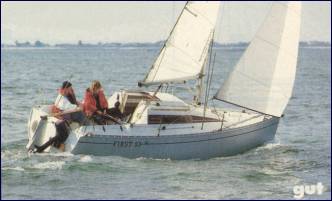 click above to view all three
boats
click above to view all three
boats |
Hull
and Deck Design
All three boats are built around a compromise: a higher
standing room in the cabin requires high freeboards and
high coach roofs. The First and Tonic have a well balanced
design, whereas the Gib’Sea does not look as elegant.
The underwater hull is flat on all three boats and offers
good form stability. Despite a very wide stern, all three
boats flow well through the water. The plumb bow of the
First is unusual but gives the boat a very long waterline.
First: good; Gib’Sea: acceptable; Tonic: good.
|
|
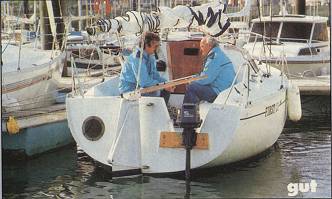 click above to view all three
boats
click above to view all three
boats |
Cockpit
and Storage
The high freeboard not only increases the size of the main
cabin – it also allows for space under the cockpit.
All three boats have an aft cabin under the cockpit but also
found enough space for a large storage locker and for a liferaft,
which is remarkable. All three cockpits are ergonomically
well designed and the sidedecks of the Tonic are best for
trimming the boat. The Gib’Sea and Tonic have a well
for the outboard engine, whereas the smaller First has a mount
on the transom, allowing easy access to the engine.
First: good; Gib’Sea: good; Tonic: good. |
|
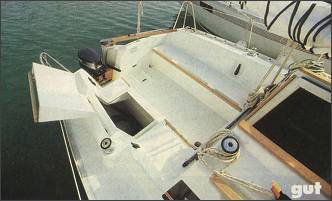
click above to view all three boats |
Main
Cabin and Berths
The Tonic has the highest cabin at 1.67 meter, whereas the
Gib’Sea and First offer 1.64 m and 1.63 m respectively.
Under the companionway hatch the Gib’Sea offers 1.78
meter. The main cabin berths can be widened to a comfortable
90 cm each on the First by lowering the table, whereas the
table is fixed on the Tonic and Gib’Sea, which therefore
only offer 68cm and 63 cm wide berths. The length of the berths
is over 2 meter on all boats. The Gib’Sea and Tonic
have upholstered back cushions, improving the comfort when
seated around the table. All three cabins are clear and well
lit.
First: good; Gib’Sea: good; Tonic:
good. |
|
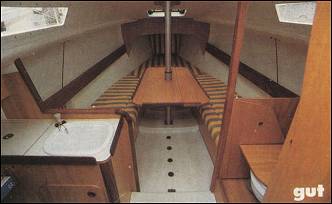 click above to view all three
boats
click above to view all three
boats |
Navigation
A separate navigation table could only be added to the smaller
First in the head compartment. But the unique compromise of
having the head compartment double as nav station works well.
All three nav stations allow you to work efficiently on charts,
come with some storage for the usual instruments and allow
you to sit while working. On the Tonic and First you sit backwards,
which needs some adjustment. None of the boats have closing
cabinets for books, and the First has no proper storage for
charts. The navigation table on the Tonic is a bit too high.
First: good; Gib’Sea: good; Tonic: good. |
|
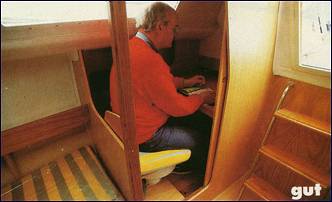 click above to view all three
boats
click above to view all three
boats |
Galley
All three galleys are L-shaped and offer more working
and storage space than on previous boats of similar length.
Had the galleys offered better storage for dishes and glassware
they would have been truly practical. None of the boats offer
a silverware tray. Only the First has an icebox. The water
supply is also unsatisfactory: only 20 liters (4.5 gallons)
on the Tonic and Gib’Sea. The First does a better job
with 50 liters (11 gallons). Larger tanks should be added
on board.
First:Not ok; Gib’Sea:not ok; Tonic:Not OK. |
|
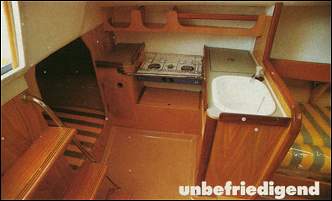 click above to view all three
boats
click above to view all three
boats |
Aft
Cabin
Due to its shorter overall length the First also has the smallest
aft cabin, with the lowest clearance to the cockpit floor
and with the narrowest entrance. This being said, the aft
cabins on all three boats are surprisingly large and two children
(or two adults in a pinch) can sleep here in comfort. All
three boats lack an opening portlight to supply some fresh
air to the aft cabin. The First and Tonic have a fixed portlight
on the stern, whereas the aft cabin on the Gib’Sea is
quite dark. None of the cabins are separated from the main
cabin, and a curtain might be a good addition. All three have
some storage in the cabin.
First: ok; Gib’Sea: good; Tonic: good |
|
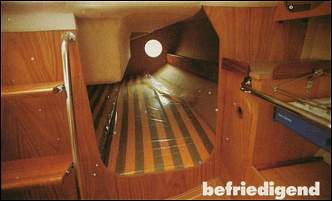
click above to view all
three boats |
Head
Compartment
These compartments literally had to be squeezed into these
small boats, making them comfortable only for smaller persons.
Yet all three heads are acceptable compromises – even
the double-function compartment on the First. Many boats of
this size only offer a portable head under a main cabin berth,
so the double-function head on the First is not that shocking.
The largest head is on the Tonic, which also has a hand wash
basin and a cloth hanging bar. The Gib’Sea has a hand
wash basin whereas the First does not. None of the boats have
opening portlights for ventilation in the head compartment.
First: acceptable; Gib’Sea: acceptable;
Tonic: good |
|
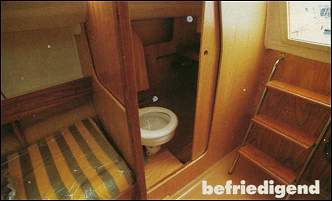
click above to view all
three boats |
| |
|
|
Return to First
235 Reviews Index




 If
the sails are reefed in time, the boat is very stable for its
size. The capsize screen is reasonable. We only tested the fixed
keel version, not the version with the longer, thinner swing
keel. The ballast is lighter in this swing keel version, but
since the keel is longer the ballast center of gravity will
be lower. Altogether there are four different keel configurations
available.
If
the sails are reefed in time, the boat is very stable for its
size. The capsize screen is reasonable. We only tested the fixed
keel version, not the version with the longer, thinner swing
keel. The ballast is lighter in this swing keel version, but
since the keel is longer the ballast center of gravity will
be lower. Altogether there are four different keel configurations
available.






